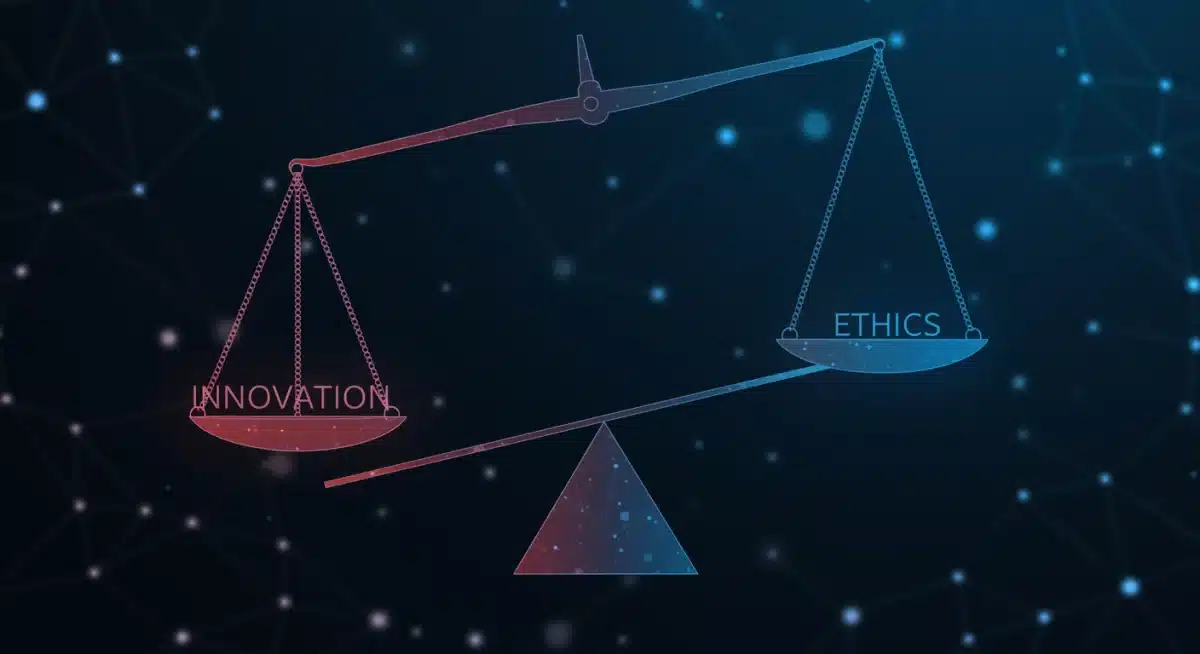Ethical AI Development: Framework for US Innovation by 2025

The US is rapidly advancing towards establishing a comprehensive framework for ethical AI development by 2025, aiming to balance innovation with critical safeguards for responsible technology deployment.
The push for Ethical AI Development: A Framework for Responsible Innovation in the US by 2025 is gaining significant momentum, as policymakers and industry leaders work to establish critical guidelines. This initiative seeks to ensure that as artificial intelligence advances, its deployment remains aligned with societal values and minimizes potential harms.
The Urgency for Ethical AI Standards
The rapid evolution of artificial intelligence technologies has underscored an urgent need for clear ethical standards. As AI integrates into every facet of society, from healthcare to defense, the potential for both immense benefit and significant harm becomes increasingly apparent. Governments, tech companies, and civil society organizations are now converging on the understanding that a proactive approach is essential to steer AI development responsibly.
Recent incidents involving algorithmic bias, privacy breaches, and autonomous system failures have highlighted the real-world consequences of unchecked AI. These events serve as stark reminders that technological advancement, while powerful, must be tempered by a robust ethical framework to prevent unintended negative impacts. The current landscape demands immediate action to establish guidelines that can keep pace with innovation.
Addressing Algorithmic Bias
Algorithmic bias remains a critical concern in AI development. This bias can perpetuate and even amplify existing societal inequalities if not meticulously addressed during design and deployment. Experts are calling for diverse datasets and rigorous testing protocols to mitigate these risks effectively.
- Data Diversity: Ensuring training datasets reflect broad demographic representation.
- Fairness Metrics: Developing and implementing quantifiable measures of algorithmic fairness.
- Human Oversight: Maintaining human review in critical decision-making processes involving AI.
- Transparency: Making the decision-making processes of AI systems more understandable.
Key Pillars of the Proposed US Framework
The proposed framework for ethical AI development in the US by 2025 is structured around several key pillars designed to foster responsible innovation. These pillars aim to create a comprehensive ecosystem where AI technologies can thrive while respecting fundamental human rights and societal values. This multi-faceted approach acknowledges the complexity of AI and the diverse stakeholders involved.
Central to this framework is the concept of a shared responsibility, where government, industry, academia, and the public all play a role in shaping AI’s future. The framework emphasizes not just regulation, but also education, research, and collaborative standard-setting. It seeks to be adaptable, recognizing that AI technology will continue to evolve at a rapid pace.
Privacy and Data Security
Protecting user privacy and ensuring robust data security are fundamental components of any ethical AI framework. The framework proposes stringent guidelines for how personal data is collected, stored, processed, and utilized by AI systems, aiming to prevent misuse and unauthorized access.
Transparency and Explainability
For AI systems to be trusted, their operations must be transparent and their decisions explainable. The framework advocates for mechanisms that allow users and regulators to understand how AI systems arrive at their conclusions, especially in high-stakes applications. This includes clear documentation and accessible explanations.
Governmental Initiatives and Policy Directions
Various governmental bodies in the US are actively engaged in shaping policy directions for ethical AI. Recent legislative proposals and executive orders indicate a strong commitment to establishing a coherent national strategy. These initiatives aim to provide clarity for developers and deployers of AI, fostering an environment where innovation can flourish responsibly.
The National Institute of Standards and Technology (NIST) has been at the forefront, developing an AI Risk Management Framework designed to help organizations manage the risks associated with AI. This framework provides guidance on mapping, measuring, and managing AI risks, offering a voluntary yet influential standard for the industry. Other agencies are also contributing to sector-specific guidelines.
Collaboration Across Agencies
Effective AI governance requires a coordinated effort across multiple government agencies. Departments ranging from Defense to Commerce are collaborating to ensure that ethical considerations are embedded in all AI-related policies and procurements. This inter-agency cooperation is vital for a unified national approach.
Industry Adoption and Best Practices
The private sector is increasingly recognizing the imperative of ethical AI development, moving beyond mere compliance to proactive adoption of best practices. Leading technology companies are investing heavily in dedicated AI ethics teams, developing internal guidelines, and participating in multi-stakeholder initiatives to shape industry standards. This shift reflects a growing understanding that responsible AI is not just a regulatory burden, but a competitive advantage and a driver for sustained public trust.
Many corporations are now integrating ethical considerations into the entire AI lifecycle, from design and development to deployment and monitoring. This includes implementing ‘ethics by design’ principles, conducting regular ethical audits, and establishing clear accountability mechanisms. The goal is to embed ethical thinking into the corporate culture, ensuring that AI innovations align with societal good.
Ethical AI by Design
The concept of ‘Ethical AI by Design’ encourages developers to consider ethical implications from the very beginning of the AI development process. This proactive approach helps to identify and mitigate potential risks before they become ingrained in the technology.
- Early Risk Assessment: Identifying potential ethical pitfalls at the conceptual stage.
- Stakeholder Inclusion: Involving diverse perspectives in the design process.
- Continuous Monitoring: Implementing systems for ongoing ethical evaluation of AI.
- Feedback Loops: Establishing mechanisms for user and public feedback on AI performance.
Challenges and Opportunities in Implementation
Implementing a comprehensive ethical AI framework by 2025 presents both significant challenges and unparalleled opportunities. The dynamic nature of AI technology means that regulations must be flexible enough to adapt to future advancements, yet robust enough to provide meaningful guardrails. Balancing innovation with oversight is a delicate act, requiring continuous dialogue and calibration among all stakeholders.
One primary challenge lies in achieving global harmonization of AI ethics. As AI systems are often developed and deployed across borders, differing national regulations could create complexities. However, this also presents an opportunity for the US to lead in establishing international norms and fostering global collaboration on responsible AI. The framework aims to be a model that can inspire similar initiatives worldwide.

Ensuring Enforcement and Accountability
A key challenge is establishing effective enforcement mechanisms and clear lines of accountability for ethical breaches. The framework must define who is responsible when AI systems cause harm and how redress mechanisms will operate. This includes exploring new legal and regulatory tools tailored to AI’s unique characteristics.
The Role of Public Engagement and Education
Public engagement and education are crucial for the successful implementation and long-term acceptance of ethical AI. A well-informed populace is better equipped to understand the benefits and risks of AI, participate in policy discussions, and hold developers and deployers accountable. This involves demystifying AI and fostering a broader understanding of its societal implications.
Educational initiatives can range from promoting AI literacy in schools to public awareness campaigns about ethical AI principles. Encouraging citizen participation in AI governance through forums and consultations can help ensure that the framework reflects diverse societal values. Empowering the public is essential for building trust and ensuring that AI serves humanity’s best interests.
Building AI Literacy
Increasing AI literacy across all segments of society is vital. This includes explaining how AI works, its capabilities, and its limitations, thereby reducing misconceptions and fostering informed public debate.
| Key Aspect | Brief Description |
|---|---|
| Algorithmic Bias Mitigation | Strategies to ensure fairness and prevent discrimination in AI systems. |
| Data Privacy & Security | Guidelines for responsible data handling and protection within AI applications. |
| Transparency & Explainability | Methods to make AI decision-making processes understandable and auditable. |
| Accountability Mechanisms | Defining responsibility and redress for potential harms caused by AI. |
Frequently Asked Questions About Ethical AI Development
The primary goal is to foster responsible innovation in AI by establishing clear ethical guidelines and safeguards. This ensures that AI technologies advance while upholding societal values, protecting individual rights, and minimizing potential risks and harms to the public.
The framework addresses algorithmic bias through mandates for diverse training datasets, the development of fairness metrics, and the promotion of human oversight in critical AI-driven decisions. These measures aim to prevent AI systems from perpetuating or amplifying existing societal inequalities.
Transparency is crucial for building trust in AI systems. The framework emphasizes making AI’s decision-making processes understandable and explainable. This allows users and regulators to comprehend how AI arrives at its conclusions, especially in sensitive applications like finance or healthcare.
Enforcement involves a shared responsibility among government agencies, industry organizations, and regulatory bodies. The framework outlines mechanisms for accountability, defining who is liable for ethical breaches and establishing redress processes to ensure compliance and public protection.
Public engagement and education are vital. This includes promoting AI literacy, fostering understanding of AI’s implications, and encouraging citizen participation in policy discussions through forums and consultations. This ensures the framework reflects diverse societal values and builds trust.
Looking Ahead
The establishment of a robust framework for Ethical AI Development: A Framework for Responsible Innovation in the US by 2025 is not merely a regulatory exercise; it’s a foundational step towards securing a future where AI serves as a powerful tool for good. The ongoing efforts by government, industry, and civil society indicate a collective recognition of AI’s transformative potential, coupled with a firm commitment to mitigating its risks. The coming months will see continued legislative debates, increased industry adoption of voluntary standards, and further public discourse. The success of this framework will ultimately hinge on its adaptability, its capacity for global influence, and its ability to continuously balance rapid innovation with unwavering ethical principles, setting a precedent for AI governance worldwide.





